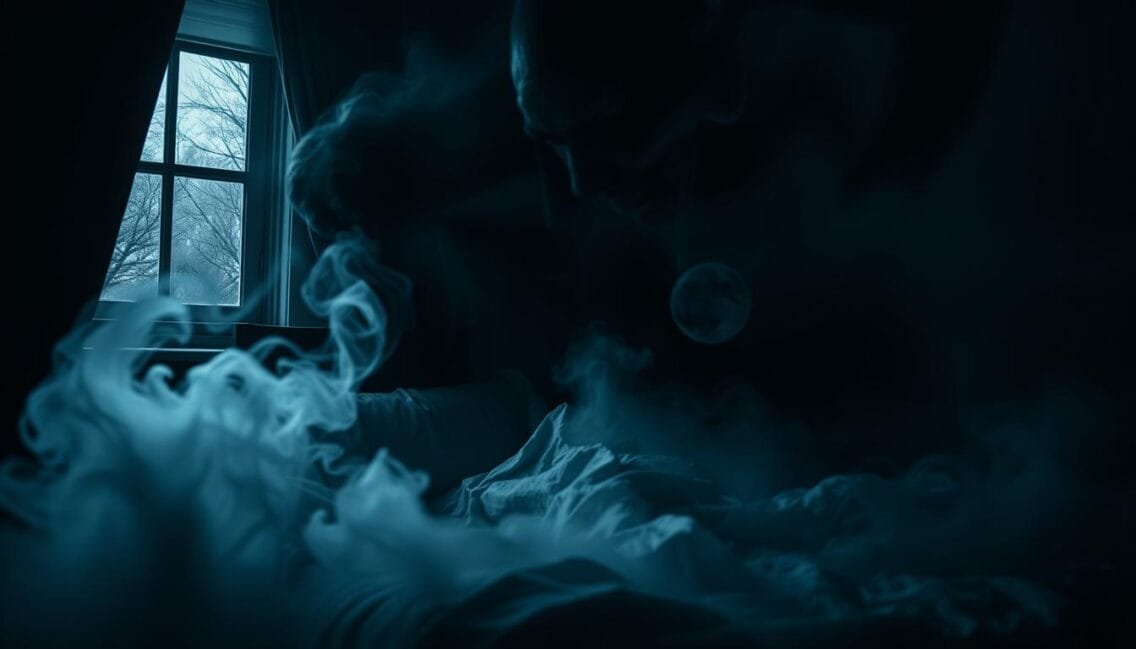Sleep Paralysis – Eerie Facts: What Science Reveals

As I lay in bed, staring into the darkness, a sudden chill ran down my spine. My heart raced as I became acutely aware of my surroundings, yet I found myself utterly paralyzed, unable to move a muscle. In the distance, I sensed a sinister presence, a looming figure that seemed to loom over me. This was no ordinary nightmare – it was the chilling experience of sleep paralysis, a perplexing phenomenon that has baffled and intrigued humanity for centuries.
Sleep paralysis, a condition that affects approximately of the general population, is a captivating intersection of science, history, and the human experience1. This parasomnia, characterized by a temporary inability to move or speak, often accompanied by vivid hallucinations, has long captured the imagination of researchers and the public alike. As we explore the eerie facts behind this condition, we gain a deeper understanding of the complex relationship between our conscious and unconscious minds.
Key Takeaways
- Sleep paralysis affects around 7.6% of the population, with a higher prevalence among students at 28.3%1.
- Individuals with poor sleep hygiene, such as sleeping less than 6 hours or more than 9 hours, are more susceptible to sleep paralysis1.
- Hallucinations during sleep paralysis can be categorized into three types: sensed presence, incubus, and vestibular-motor1.
- Sleep paralysis occurs when the brain becomes partly awake during the REM phase of sleep, while the body remains paralyzed1.
- Sleep paralysis may have contributed to historical accounts of supernatural entities and ghost stories1.
Understanding the Phenomenon of Sleep Paralysis
Sleep paralysis is a strange and scary experience. It happens when our brain and body don’t sync up during sleep. This is because our body naturally stops moving during the REM sleep phase to prevent acting out dreams2.
The Science Behind REM Sleep
REM sleep makes our muscles temporarily paralyzed, called REM atonia. This keeps us safe while dreaming. But, in sleep paralysis, our brain wakes up while our body stays still. This creates a mix-up between being asleep and awake3.
When Dreams Meet Reality
Sleep paralysis can make us see and feel things that aren’t there. It feels like someone or something supernatural is in the room. These dream-like visions mix with our real awareness, making it very scary3.
Common Symptoms and Experiences
People with sleep paralysis can’t move or speak. They might feel pressure on their chest and see vivid hallucinations. This happens because their brain is awake but their body is still23.
Even though it’s scary, sleep paralysis isn’t rare. It affects 8 percent of the general population2. Episodes can last up to several minutes. About 75 percent of sleep paralysis episodes involve hallucinations2. Knowing how it works can help people deal with its scary symptoms.
Sleep Paralysis – Eerie Facts: The Historical Perspective
Sleep paralysis has fascinated people for centuries, with the first medical records from the 17th century. Dutch physician Isbrand Van Diembroeck wrote one of the first medical accounts. This sparked a long debate between sleep paralysis myths vs. science4.
Many cultures have seen sleep paralysis as a sign of supernatural events. These include demonic possession, alien abductions, and mythical creatures4.
These beliefs have lasted even when science explained it. They shape how people see and deal with sleep paralysis in different places4.
For thousands of years, people have reported seeing sexual demons, beasts, and ghosts during sleep paralysis4. It’s also linked to UFO abduction stories and alien encounters4.
In 2012, University of Toronto neuroscientists found out what happens in sleep paralysis. They found it involves muscle control and amino acids4. This research has helped clear up the mystery of sleep paralysis myths vs. science.
One cool thing about sleep paralysis is you can dream lucidly and control your dreams4. Sleep Paralysis Signalling (SPS) is a method to move from sleep paralysis to lucid dreaming. This lets people see and control their dreams4. When managed well, sleep paralysis can be seen as a gift, not a curse4.
As we learn more about sleep paralysis myths vs. science, it’s clear it has always fascinated us. By looking at history and science, we can understand the complex and interesting nature of sleep paralysis.
The Brain Chemistry During Sleep Paralysis Episodes
Sleep paralysis is a complex mix of brain activity and neurotransmitters. It happens when the brain is both asleep and awake at the same time5. The serotonin 2A receptor (5-HT2AR) is key, causing hallucinations and out-of-body experiences5. This receptor is important for how we see things and have visual hallucinations5.
Neurological Mechanisms
The brain’s REM sleep state makes us feel scared and paranoid during sleep paralysis5. Changes in 5-HT2A receptors in the brain can lead to hallucinations in people with schizophrenia and Parkinson’s5. These receptors also affect how we see ourselves and our surroundings5.
The temporoparietal junction (TPJ) is linked to out-of-body experiences and seeing things that aren’t there5.
Role of Neurotransmitters
During sleep paralysis, the brain’s muscle-paralyzing neurotransmitters stay active while we’re awake5. The 5-HT2A receptors make us see meaning in things that don’t have any5. This can make us feel like we’re not really there and experience “ego dissolution”5.
Sleep-Wake Cycle Disruption
Disruptions in sleep can lead to sleep paralysis6. Adults need 90 to 110 minutes of REM sleep each night6. Stress, lack of sleep, and sleep disorders like sleep apnea can cause it6.
Common Hallucinations and Sensory Experiences
Sleep paralysis often brings vivid and scary hallucinations. These can affect how we see reality. They can include sights, sounds, feelings, and smells. About 20% of people have sleep paralysis sometimes7. In 75% of these cases, they see or hear something strange7.
People often feel a bad presence, heavy chest pressure, or feel like they’re floating8. These feelings can be so real. Some think they’ve met “sleep demons” or aliens8.
- Sensory hallucinations during sleep paralysis can affect various modalities, including visual (flashes, human figures), auditory (whispers, buzzing), tactile (feeling touched or pressure), and even rare olfactory (sense of smell) experiences8.
- Factors that may contribute to the intensity and frequency of these hallucinations include anxiety disorders, poor sleep quality, alcohol consumption, traumatic events, and a family history of sleep paralysis8.
These scary experiences might explain many supernatural stories and alien sightings7. The reasons behind these hallucinations are still a mystery. But studying sleep paralysis helps us understand our minds better.
Cultural Interpretations Across the Globe
Sleep paralysis is seen differently in cultures worldwide. It’s a mysterious sleep disorder that can make people feel trapped in their sleep. This feeling can lead to various beliefs and fears9.
People often feel intense anxiety and can’t move or speak. They might even fear death9.
Ancient Beliefs and Folklore
In Egypt, sleep paralysis is blamed on supernatural beings called jinn10. In Italy’s Abruzzo region, it’s linked to the Pandafeche, a witch-like figure10. South African Indigenous people believe in tokoloshe, small creatures that cause sleep paralysis10.
Turkish folklore talks about karabasan, spirit-like entities10. These beliefs shape how people deal with sleep paralysis.
Modern Cultural Perspectives
In Denmark, sleep paralysis is seen as a stress issue10. In the U.S., it’s less common because of cultural and fear of mental illness10. Places with folklore about sleep paralysis report more cases, making it a common experience10.
Scientific vs Traditional Explanations
Different cultures have their own patterns of symptoms for sleep paralysis10. People without cultural knowledge can still see it as a spiritual event10. Science and spirituality can both play a role in understanding sleep paralysis10.
In America, alien abduction themes are common, leading to supernatural views10.
Cultural stories worldwide shape how sleep paralysis is seen and experienced10. More research is needed to understand the mix of dreams, culture, and sleep disorders109.
Risk Factors and Triggers
Sleep paralysis is a mysterious condition that many people face. While we don’t know all the reasons, research has found some risk factors and triggers11112.
Poor sleep quality is a big risk factor. People who don’t get enough sleep or have irregular sleep patterns are more likely to experience it1. Shift workers with sleep disorders are also at higher risk11.
Stress and anxiety are also key factors. Those with anxiety and depression are more likely to have sleep paralysis episodes11. Traumatic events and emotional distress can also trigger it12.
How you sleep can also matter. Sleeping on your back can increase your chances of sleep paralysis11. Most episodes happen when you’re falling asleep or waking up11.
Genetics might also play a part. People with a family history of sleep paralysis might be more at risk12. But we still don’t know the exact genetic link.
Knowing the causes and risk factors of sleep paralysis is important. It helps us find ways to prevent and manage it. By improving sleep, managing stress, and keeping healthy sleep habits, we can reduce sleep paralysis episodes.
The Connection Between Sleep Paralysis and Mental Health
Sleep paralysis is a scary experience where you can’t move or speak when waking up. It’s linked to mental health issues13. People with anxiety or depression are more likely to have it. This can make their mental health problems worse14.
Anxiety and Depression Links
Research in Egypt and Italy found a strong link between sleep paralysis and anxiety14. The scary nature of these episodes can deeply affect a person’s well-being.
Impact on Sleep Quality
Sleep paralysis disrupts normal sleep patterns14. It affects 10% of people, leading to insomnia and fatigue. This worsens mental health issues.
Psychological Effects
Sleep paralysis can be very traumatic, with hallucinations and a feeling of being trapped14. It can cause anxiety, panic, and even PTSD. This can harm a person’s mental health and quality of life.
It’s important to understand the link between sleep paralysis and mental health13. Healthcare professionals can help manage sleep paralysis. This can reduce its long-term effects on mental health.
Prevention Strategies and Management Techniques
Managing sleep paralysis involves several steps. These include improving sleep habits, tackling psychological issues, and finding ways to cope15. Keeping a regular sleep schedule and creating a cozy sleep space can help15. Cutting down on caffeine and alcohol is also key15.
Some people find meditation and muscle relaxation helpful15. These practices can ease the symptoms of sleep paralysis15.
Telling patients that sleep paralysis is harmless can lessen their fear15. This knowledge helps them handle episodes better15. It’s also important to deal with any mental health issues, like anxiety or PTSD, to prevent sleep paralysis16.
Regular exercise and a steady sleep schedule can lower the risk of sleep paralysis16. Sleeping on your side instead of your back can also help16. In some cases, doctors might prescribe medication, like stimulants or antidepressants, to help manage sleep paralysis15.
Combining lifestyle changes, psychological help, and medical treatment can prevent and manage sleep paralysis17.
Latest Research and Scientific Discoveries
Recent studies have uncovered new insights into sleep paralysis. They are looking into how the brain works and how culture affects it. This research aims to make sleep paralysis easier to understand and manage18.
Neurotransmitters play a big role in sleep-wake cycle issues seen in sleep paralysis. Researchers think that drugs like pimavanserin might help with the hallucinations18.
Genetic studies are also underway. They aim to find out why some people get sleep paralysis. This could lead to treatments tailored to each person’s needs18.
Cultural beliefs also shape how people experience sleep paralysis. Those who think it’s supernatural tend to have more vivid hallucinations and fear18.
There’s a link between sleep paralysis and mental health issues like anxiety and depression. Researchers are looking into how these conditions might affect each other18.
The scientific community is working hard to understand sleep paralysis better. They want to find ways to prevent and manage it181920.
Conclusion
Exploring sleep paralysis reveals its deep complexities. Science has made progress, but how our bodies and beliefs interact is still a mystery21. People often feel trapped and see scary things, showing how much it affects them.
Looking at history and different cultures shows how deeply rooted sleep paralysis is22. Up to 30% of people might have an episode, and in places like Egypt, it’s seen as a big threat23. With 8% of people experiencing it, and more among students and those with mental health issues, we need to study it more.
Recent research gives us hope for better treatments and understanding212322. It shows how our brains, chemicals, and sleep cycles are connected. By learning more about sleep paralysis, we can better appreciate human sleep and the need for more research.
FAQ
What is sleep paralysis?
How common is sleep paralysis?
When does sleep paralysis occur?
What causes the symptoms of sleep paralysis?
How have cultures throughout history interpreted sleep paralysis?
What is the neurological basis of sleep paralysis?
What are the common hallucinations experienced during sleep paralysis?
How do different cultures interpret and cope with sleep paralysis?
What are the risk factors and triggers for sleep paralysis?
How is sleep paralysis linked to mental health issues?
How can sleep paralysis be managed and prevented?
What are the latest research and scientific discoveries on sleep paralysis?
Source Links
- https://www.medicalnewstoday.com/articles/321569 – Sleep paralysis: What is it, and how can you cope with it?
- https://www.discovermagazine.com/health/5-mysterious-facts-about-sleep-paralysis – What Really Happens During Sleep Paralysis and How to Stop It
- https://www.sleepstation.org.uk/articles/sleep-disorders/sleep-paralysis/ – Sleep paralysis. A Demon in your bedroom?
- https://aeon.co/essays/the-terror-and-the-bliss-of-sleep-paralysis – The terror and the bliss of sleep paralysis | Aeon Essays
- https://pmc.ncbi.nlm.nih.gov/articles/PMC6208952/ – The neuropharmacology of sleep paralysis hallucinations: serotonin 2A activation and a novel therapeutic drug
- https://eachnight.com/sleep/sleep-paralysis-neuroscience/ – The Neuroscience Behind Sleep Paralysis – eachnight
- https://www.sleepfoundation.org/parasomnias/sleep-demon – Sleep Demon: Understanding the Phenomenon
- https://www.verywellhealth.com/symptoms-of-sleep-paralysis-3014781 – EEK! What Are the Most Common (And Scary) Symptoms of Sleep Paralysis?
- https://pmc.ncbi.nlm.nih.gov/articles/PMC5013036/ – Sleep Paralysis in Brazilian Folklore and Other Cultures: A Brief Review
- https://digitalcommons.longwood.edu/cgi/viewcontent.cgi?article=1000&context=omni – The Effects of Culture on Sleep Paralysis Experiences
- https://www.verywellhealth.com/what-causes-sleep-paralysis-3014700 – Causes and Risk Factors of Sleep Paralysis
- https://www.sleepfoundation.org/parasomnias/sleep-paralysis – Sleep Paralysis: Symptoms, Causes, and Treatment
- https://www.ncbi.nlm.nih.gov/books/NBK562322/ – Sleep Paralysis – StatPearls – NCBI Bookshelf
- https://www.webmd.com/sleep-disorders/sleep-paralysis – Sleep Paralysis
- https://www.healthline.com/health/sleep/isolated-sleep-paralysis – Sleep Paralysis: Factors, Symptoms & Treatments
- https://www.healthdirect.gov.au/sleep-paralysis – Sleep paralysis
- https://www.news-medical.net/health/Sleep-Paralysis-Treatment-and-Prevention.aspx – Sleep Paralysis Treatment and Prevention
- https://www.scientificamerican.com/article/sleep-paralysis-and-the-monsters-inside-your-mind/ – Sleep Paralysis and the Monsters Inside Your Mind
- https://pmc.ncbi.nlm.nih.gov/articles/PMC10218966/ – Sleep Paralysis and Lucid Dreaming—Between Waking and Dreaming: A Review about Two Extraordinary States
- https://www.ncbi.nlm.nih.gov/pmc/articles/PMC10414800/ – Frequency and Factors of Sleep Paralysis Among Medical Students of Karachi
- https://www.boisestate.edu/presidents-writing-awards/the-science-behind-sleep-paralysis/ – The Science Behind Sleep Paralysis
- https://pillow.app/article/sleep-paralysis-separating-myths-from-facts – Sleep Paralysis Demystified: Separating Myths from Facts
- https://amerisleep.com/blog/sleep-paralysis/ – Everything You Need to Know About Sleep Paralysis – Amerisleep





